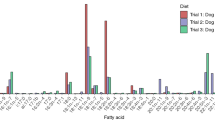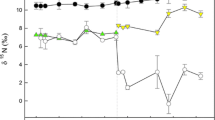Abstract
Fatty acid (FA) signature analysis is a powerful tool to investigate foraging ecology and food web dynamics in marine ecosystems. However, use of FA signatures to qualitatively or quantitatively infer diets is potentially complicated by effects of nutritional state on lipid metabolism. Estimation of diets using the quantitative fatty acid signature analysis (QFASA) model requires the use of calibration coefficients to account for predator metabolism of individual FAs. We conducted a captive feeding experiment to determine the effects of a 50% reduction in food intake on growth rate and adipose tissue FA signatures of tufted puffin (Fratercula cirrhata) nestlings, a species that routinely experiences food restriction during growth. FA signatures of chicks fed low- and high-calorie diets both exhibited a change in composition in response to the dietary shift with the direction of change in the composition of individual FAs matching the direction of change in the dietary FAs. Despite a growth rate in the restricted nestlings that was 38% of those in the well-fed group, rates of FA turnover were not different between high and low-calorie treatments, and turnover was close to, but not entirely complete, after 27 days on both high-calorie and restricted diets. FA signatures of tufted puffin nestlings were significantly affected by caloric restriction, but these effects were much less pronounced than those of dietary turnover, and calibration coefficients of puffins fed low and high-calorie diets were highly correlated. Our results demonstrate that changes in physiological state can affect FA metabolism, but future research is required to better understand whether the size of these effects is sufficient to substantially alter diet estimation using the QFASA model.





Similar content being viewed by others
References
Aitchison J (1986) The statistical analysis of compositional data. Chapman and Hall, New York
Anderson PJ, Piatt JF (1999) Community reorganization in the Gulf of Alaska following ocean climate regime shift. Mar Ecol Prog Ser 189:117–123
Back DW, Goldman MJ, Fish JE, Ochs RS, Goodridge AG (1986) The fatty acid synthase gene in avian liver: 2 messenger RNAs are expressed in parallel by feeding, primarily at the level of transcription. J Biol Chem 261:4190–4197
Bairlein F (2002) How to get fat: nutritional mechanisms of seasonal fat accumulation in migratory songbirds. Naturwissenschaften 89:1–10
Beck CA, Iverson SJ, Bowen WD, Blanchard W (2007) Sex differences in grey seal diet reflect seasonal variation in foraging behaviour and reproductive expenditure: evidence from quantitative fatty acid signature analysis. J Anim Ecol 76:490–502
Budge SM, Iverson SJ (2003) Quantitative analysis of fatty acid precursors in marine samples: direct conversion of wax ester alcohols and dimethylacetols to FAMEs. J Lipid Res 44:1802–1807
Budge SM, Cooper MH, Iverson SJ (2004) Demonstration of the deposition and modification of dietary fatty acids in pinniped blubber using radiolabeled precursors. Physiol Biochem Zool 77:682–687
Budge SM, Iverson SJ, Koopman HN (2006) Studying trophic ecology in marine ecosystems using fatty acids: a primer on analysis and interpretation. Mar Mamm Sci 22:759–801
Budge SM, Springer AM, Iverson SJ, Sheffield G (2007) Fatty acid biomarkers reveal niche separation in an Arctic benthic food web. Mar Ecol Prog Ser 336:305–309
Dalsgaard J, St John M, Kattner G, Müller-Navarra D, Hagen W (2003) Fatty acid trophic markers in the pelagic marine environment. Adv Mar Biol 46:225–340
Folch J, Lees M, Sloane-Stanly GH (1957) A simple method for the isolation and purification of total lipides from animal tissues. J Biol Chem 226:497–509
Gjerdrum C (2001) Nestling growth and parental provisioning of tufted puffins (Fratercula cirrhata) on Triangle Island, British Columbia. M.Sc. thesis, Burnaby, BC, Canada
Gjerdrum C, Vallée AMJ, St.Clair CC, Bertram DF, Ryder JL, Blackburn GS (2003) Tufted puffin reproduction reveals ocean climate variability. Proc Natl Acad Sci USA 100:9377–9382
Hatch SA, Sanger GA (1992) Puffins as samplers of juvenile Pollock and other forage fish n the Gulf of Alaska. Mar Ecol Prog Ser 80:1–14
Iverson SJ (2009) Tracing aquatic food webs using fatty acids: from qualitative indicators to quantitative determination. In: Arts MT, Brett MT, Kainz M (eds) Lipids in aquatic ecosystems (in press). Springer, New York
Iverson SJ, Frost KJ, Lowry LF (1997) Fatty acid signatures reveal fine scale structure of foraging distribution of harbor seals and their prey in Prince William Sound, Alaska. Mar Ecol Prog Ser 151:255–271
Iverson SJ, Lang SLC, Cooper MC (2001) Comparison of the Bligh and Dyer and Folch methods for total lipid determination in a broad range of marine tissue. Lipids 36:123–1287
Iverson SJ, Field C, Bowen WD, Blanchard W (2004) Quantitative fatty acid signature analysis: a new method of estimating predator diets. Ecol Monogr 74:211–235
Iverson SJ, Springer AM, Kitaysky AS (2007) Seabirds as indicators of food web structure and ecosystem variability: qualitative and quantitative diet analyses using fatty acids. Mar Ecol Prog Ser 352:235–244
Käkelä A, Crane J, Votier SC, Furness RW, Käkelä R (2006) Fatty acid signatures as indicators of diet in great skuas Stercorarius skua, Shetland. Mar Ecol Prog Ser 319:297–310
Klasing KC (1998) Comparative avian nutrition. CAB International, New York
Littell RC, Henry PR, Ammerman CB (1998) Statistical analysis of repeated measures data using SAS procedures. J Anim Sci 76:1216–1231
Moreno J (1989) Strategies of mass change in breeding birds. Biol J Linn Soc 37:297–310
Oyan HS, Anker-Nilssen T (1996) Allocation of growth in food-stressed Atlantic puffin chicks. Auk 113:830–841
Piatt JF, Kitaysky AS (2002) Tufted puffin (Fratercula cirrhata). In: Poole A, Gill F (eds) The birds of North America, No 708. The Birds of North America Inc., Philadelphia, pp 1–31
Raclot T (2003) Selective mobilization of fatty acids from adipose tissue triacylglycerols. Prog Lip Res 42:257–288
Raclot T, Groscolas R (1995) Selective mobilization of adipose tissue fatty acids during energy depletion in the rat. J Lipid Res 36:2164–2173
Raclot T, Oudart H (2000) Net release of individual fatty acids from white adipose tissue during lypolysis in vitro: evidence for selective fatty acid re-uptake. Biochem J 348:129–136
Raclot T, Groscolas R, Cherel Y (1998) Fatty acid evidence for the importance of myctophid fishes in the diet of king penguins, Aptenodytes patagonicus. Mar Biol 132:523–533
Rosen DAS, Trites AW (2000) Pollock and the decline of stellar sea lions: testing the junk-food hypothesis. Can J Zool 78:1243–1250
Wanless S, Harris MP, Redman P, Speakman JR (2005) Low energy values of fish as a probable cause of major seabird breeding failure in the North Sea. Mar Ecol Prog Ser 294:1–8
Williams CT, Buck CL, Sears J, Kitaysky AS (2007) Effects of nutritional restriction on nitrogen and carbon stable isotopes in growing seabirds. Oecologia 153:11–18
Williams CT, Iverson SJ, Buck CL (2008a) Stable isotopes and fatty acid signatures reveal age- and stage-dependent foraging niches in tufted puffins. Mar Ecol Prog Ser 363:287–298
Williams CT, Kitaysky AS, Kettle AB, Buck CL (2008b) Corticosterone levels of tufted puffins vary with breeding stage, body condition index, and reproductive performance. Gen Comp Endocrinol 158:29–35
Acknowledgments
Funding was provided by the North Pacific Research Board (NPRB #04-13) to CLB and CTW and by NOAA/NMFS (NA16FX1270) to CLB. Additional financial support was provided to CTW by AK EPSCoR, and to SJI by Natural Sciences and Engineering Research Council (NSERC), Canada. We thank T. Cooper, R. Orben, S. Runck and E. Whidden for assistance with field and laboratory work. We are grateful to S. Al-Shaghay and S. Lang for assistance with FA signature analysis. We thank the three anonymous reviewers for their helpful comments on an earlier version of this manuscript. All procedures were approved by the Institutional Animal Care and Use Committees at the University of Alaska Fairbanks (#05-43) and authorized under state and federal permits.
Author information
Authors and Affiliations
Corresponding author
Additional information
Communicated by G. Heldmaier.
Rights and permissions
About this article
Cite this article
Williams, C.T., Iverson, S.J. & Buck, C.L. The effects of diet and caloric restriction on adipose tissue fatty acid signatures of tufted puffin (Fratercula cirrhata) nestlings. J Comp Physiol B 179, 711–720 (2009). https://doi.org/10.1007/s00360-009-0354-4
Received:
Revised:
Accepted:
Published:
Issue Date:
DOI: https://doi.org/10.1007/s00360-009-0354-4




